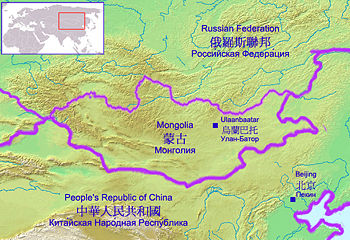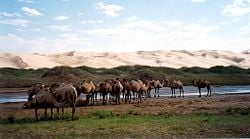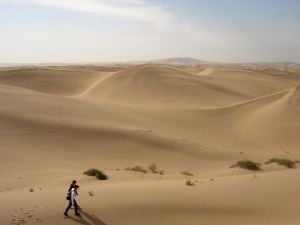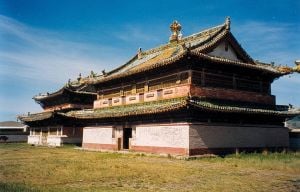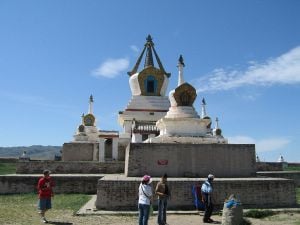Difference between revisions of "Gobi Desert" - New World Encyclopedia
Mary Anglin (talk | contribs) |
Rosie Tanabe (talk | contribs) m |
||
| (29 intermediate revisions by 7 users not shown) | |||
| Line 1: | Line 1: | ||
| − | {{ | + | {{Approved}}{{Submitted}}{{Images OK}}{{Paid}}{{copyedited}} |
| + | |||
[[Image:GobiDessertReliefMap.jpg|thumb|350px|right|The Gobi Desert lies in the territory of the [[People's Republic of China]] and the [[Mongolia|State of Mongolia]].]] | [[Image:GobiDessertReliefMap.jpg|thumb|350px|right|The Gobi Desert lies in the territory of the [[People's Republic of China]] and the [[Mongolia|State of Mongolia]].]] | ||
| − | + | ||
| − | + | The Gobi Desert, the largest in [[Asia]] and the fourth largest in the world, stretches into modern day [[China]] and [[Mongolia]], expanding its harsh, rocky terrain over 500,000 square miles. It lies in the heart of Asia's remotest area, between [[Siberia]] to the north and the [[Tibetan Plateau]] to the south, covering the southern third of Mongolia. | |
| − | |||
| − | |||
| − | |||
| − | |||
| + | Unlike the romanticized image of [[desert]]s with sweeping sand dunes, most of the landscape of the Gobi consists of rocky, hard packed terrain. While the solid land under foot made it easier to transverse the desert, catapulting the Gobi onto the scene of history as a viable trade route, there was very little settled human occupation in the area until modern times. A clue to the historical perception of the Gobi as an inhospitable region is found in its name, which derives from the Mongolian word for "very large and dry." | ||
| + | The Gobi is a rain shadow [[desert]] formed by the [[Himalayas|Himalaya]] range, which prevents rain-carrying clouds from reaching the Gobi. It is roughly crescent-shaped, lying between the [[Altai]] and [[Hangayn]] mountain ranges in the north and the [[Pei Mountains]] in the south. The eastern side of the desert is fringed by the [[Sinkiang region]], a large basin that extends towards the [[Plateau of Tibet]]. Towards the west of the Gobi lies the [[Greater Khingan Range]]. | ||
| + | {{toc}} | ||
| + | The Gobi is made up of several distinct [[ecology|ecological]] and geographic regions based on variations in climate and topography. It is most notable in history as part of the great [[Mongol Empire]], and as the location of several important cities along the [[Silk Road]]. | ||
==Geography== | ==Geography== | ||
| − | + | [[Image:Gobi Desert.jpg|thumb|250px|right|The part of Gobi Desert in the [[Inner Mongolia Autonomous Region]] of [[People's Republic of China|China]]]] | |
| + | [[Image:OmnogoviLandscape.jpg|thumb|250px|right|Gobi Desert landscape in [[Ömnögovi Province]], [[Mongolia]].]] | ||
| + | [[Image:KhongorynElsCamels.jpg|thumb|250px|right|[[Bactrian camels]] by the [[dune|sand dunes]] of Khongoryn Els, [[Gobi Gurvansaikhan National Park|Gurvansaikhan NP]], [[Mongolia]].]] | ||
| + | [[Image:Desert - Inner Mongolia edit.jpg|thumb|right|The Gobi desert in Inner Mongolia, China.]] | ||
| + | ===Ecoregions of the Gobi=== | ||
| + | The Gobi Desert is categorized by the [[World Wildlife Federation]] as consisting of two broadly defined ecoregions: The Gobi Steppe Desert and the Gobi Lakes Valley Desert Steppe region. | ||
| − | The Gobi | + | The '''Eastern Gobi Desert Steppe''' lies in the eastern portion of the Gobi Desert, reaching from the [[Inner Mongolia Palteau]] (found in [[China]]) into [[Mongolia]]. Overall, this region covers an area of approximately 108,800 square miles before its borders fade into the lush grasslands of Mongolia and [[Manchuria]]. Salt marshes and small ponds are commonly found in the lower elevations in this area, but disappear when the elevation rises to form the [[Yin Shan Mountain Range]]. The Eastern Gobi Desert Steppe is categorized by drought–adapted [[plant]] life and occasional thin wild grass patches. The Gobi Desert also harbors a few plant species that have been useful for both [[animal]]s and [[human]]s alike, including: [[Wormwood]], [[garlic|wild garlic]], [[saltwort]], and [[onion|wild onion]]. |
| − | + | While the harsh environment and lack of visible vegetation may make the Gobi Desert appear inhospitable and unoccupied, the reverse appears to be true upon closer examination. The desert teems with life, boasting particularly large populations of [[Asian wild ass]], [[Saiga antelope]], [[black-tailed gazelle]], and [[marbled polecat]]. Smaller animals and [[insect]]s also contribute to the desert [[ecosystem]], along with sizable [[bird]] populations. | |
| − | The [[ | + | The other ecosystem recognized by the World Wildlife Federation in the Gobi Desert is the '''Gobi Lakes Valley Desert Steppe,''' situated between the [[Khangai range]] and the [[Gobi-Altai]] and [[Mongol-Altai]] ranges in southwestern Mongolia. The Gobi Lakes Valley Desert Steppe is actually quite small for a complete ecosystem, measuring only 500 km long and 150 km wide. Despite its size, however, the region offers a broad range of landscape diversity, ranging from sand dunes to salt marshes. The most distinct feature of the area, however, and the one that earned the region its name, is the large number of lakes that dot the landscape. These lakes, mainly the [[Orog]], [[Boontsagaan]], [[Taatsyn tsagaan]], and the [[Ulaan nuur]] provide an unusual geographic feature for an area technically classified as a desert. |
| − | + | Like the East Gobi Desert Steppe, all the plant life found in the Gobi Lakes Valley Desert Steppe region has adapted to the harsh conditions of life in the desert. In addition to the plants found in the East Gobi, the [[lake]]s of this region support a thriving aquatic community complete with marine animals and water-dwelling plant forms. Lakes and marshes also provide a valuable habitat for [[bird]] communities. | |
| − | + | In regard to the mammalian occupants of the Gobi Lakes Valley, most of the species are able to survive in the difficult terrain by using the terrain to their best advantage. Common species found in the Gobi include: [[Midday gerbil]], [[dwarf hamster]], [[long-eared hedgehog]], and the [[Tibetan hare]]. Smaller animals like these are able to hide in the shade during the heat of the day and avoid direct exposure to the glaring midday sun. Some larger animals, however, also choose to make the Gobi Lakes Valley Desert Steppe their home, including [[black-tailed Gazelle]], [[Mongolian gazelle]], and [[wild mountain sheep]] in the more mountainous regions. | |
| − | |||
| − | + | ====Alternatively defined ecoregions==== | |
| − | + | Alternative sources recognize [[ecoregion]]s in the Gobi with the following definition: | |
| − | |||
| − | |||
| − | |||
| − | |||
| − | |||
| − | |||
| − | |||
| − | |||
| − | |||
| − | |||
| − | |||
| − | |||
| − | |||
| − | |||
| − | |||
| − | |||
| − | |||
| − | |||
| − | |||
| − | |||
| − | |||
| − | + | The '''Eastern Gobi desert steppe''' is the easternmost of the Gobi ecoregions, covering an area of {{convert|281800|sqkm|sqmi|0|abbr=on}}. It extends from the [[Inner Mongolia]]n [[Plateau]] in China northward into Mongolia. It includes the [[Yin Mountains]] and many low-lying areas with salt pans and small ponds. It is bounded by the [[Mongolian-Manchurian grassland]] to the north, the Yellow River Plain to the southeast, and the Alashan Plateau semi-desert to the southeast and east. | |
| − | + | The '''Alashan Plateau semi-desert''' lies west and southwest of the Eastern Gobi desert steppe. It consists of the desert basins and low mountains lying between the Gobi Altay range on the north, the [[Helan Mountains]] to the southeast, and the [[Qilian Mountains]] and northeastern portion of the Tibetan Plateau on the southwest. | |
| − | + | The '''Gobi Lakes Valley desert steppe''' ecoregion lies north of Alashan Plateau semi-desert, between the Gobi Altay range to the south and the [[Khangai Mountains]] to the north. | |
| − | + | The '''Junggar Basin semi-desert''' includes the desert basin lying between the Altay mountains on the north and the [[Tian Shan]] range on the south. It includes the northern portion of China's Xinjiang province and extends into the southeastern corner of Mongolia. The Alashan Plateau semi-desert lies to the east, and the [[Emin Valley steppe]] to the west, on the China-[[Kazakhstan]] border. | |
| − | The | ||
| − | + | The '''Tian Shan range''' separates the Junggar Basin semi-desert from the [[Taklamakan Desert]], which is a low, sandy desert basin surrounded by the high mountain ranges of the Tibetan Plateau to the south and the [[Pamir Mountains|Pamirs]] to the west. The Taklamakan Desert ecoregion includes the [[Desert of Lop]]. | |
| − | + | ===Sands of the Gobi Deserts=== | |
| − | + | Despite the fact that much of the Gobi desert consists of gravel or rocky terrain, the few sand dunes that do exist continue to draw [[science|scientific]] inquiry and tourists alike. There are two major theories about the origins of the sand dunes in Mongolia. One theory, which is the more popular theory among scientists, states that the sands were carried into the desert on wind currents, much the way that [[water]] can carry sand. This theory has gained popularity as science has been able to track wind currents in the region, and the sand dunes have been proven to have developed along traditional wind paths. While this is the more predominant theory, an alternative idea exists that claims the sand dunes were originally a product of water erosion. | |
| − | == | + | ===Climate=== |
| − | |||
| − | The | + | The Gobi Desert is noted for its extreme [[temperature]] variation, with days commonly dipping from sweltering midday heat to freezing temperatures at night. During the [[winter]], the Gobi Desert experiences extremely low temperatures that are not found in other surrounding areas of China and Mongolia. The reason for the the cooler temperatures, like the formation of the sand dunes, is theorized to be the result of the strong winds that sweep across the [[plains]] of the Gobi Desert. Unstopped by any significant [[mountain]] formations, the winds add a chill to the temperature that makes life in the winter Gobi Desert particularly difficult. |
| − | The | + | The summer season, while marked by temperatures rising towards 100°F, is the rainy season for the Gobi Desert. The high temperatures bring with them the promise of [[rain]], which is much needed for the inhabitants of the desert. While a welcome respite from the heat, the rains never seem to last long enough, annually only dropping about 4 to 6 inches (100 to 150 mm) on the plains. |
| − | + | ===Conservation efforts=== | |
| − | The | + | The [[grassland]]s of the Gobi Desert are under extreme threat and may one day completely disappear if current practices in the region continue. The main culprit for the degradation of the grasslands is [[overgrazing]] by [[goat]]s in the region, whose sheering fetches a high price in the form of [[cashmere]]. The problem of overgrazing has become compounded in recent years, as more and more people return to an [[agriculture|agricultural]] lifestyle after the destruction of much of the urban economy of Mongolia. |
| − | The | + | The increase of agriculturalists in the area also threatens to detach much of the sand and topsoil in the desert. Under this threat, the loose sand or topsoil potentially could be swept away by the winds. This process is known as [[desertification]], and is a common situation faced by deserts around the world. |
| − | + | On a scientific level, the Gobi Desert has also proven to be a valuable resource that needs to be conserved for future generations. The Gobi Desert harbors rich [[fossil]] remains, including [[dinosaur]] eggs and bones. Particularly, the Gobi Desert has been used to study the phenomenon commonly referred to as a "sand slides," where particle matter shifted on to living animals. This process, which resulted in death and physical preservation of the body, provides an important component for analyzing the extinction of dinosaurs. | |
| − | |||
| − | |||
| − | The | + | ==History== |
| + | The ancient [[Silk Road]] traversed the southern part of the [[Ala Shan Desert]] and crossed the Ka-shun Gobi as it skirted north and west around the [[Takla Makan Desert]]. The Gobi Desert remained relatively unknown to Western Europe until [[Marco Polo]] brought back his personal accounts of travel in the thirteenth century. Many other explorers followed Polo's example and voyaged through the Gobi Desert on the way to [[China]]. This trend led to an image, in Western Europe, of a Gobi Desert that was shaped by personal accounts and perceptions, not necessarily fact. | ||
| − | + | The harsh environment of the Gobi has proven prohibitive throughout history to permanent settled communities, and little of the advanced [[civilization]]s of [[China]] trickled into the desert. Those who did transverse the difficult terrain in its early history where commonly traders. Deserts often have to be crossed in order to reach potential markets, and the Gobi Desert was no exception. Trade routes dotted the gravel landscape, connecting the cities of Kalgan, Suzhou, Hami, and Beijing for economic purposes. Another significant route connected Kwei-hwa-cheng, Hami, annd Barku, while yet another ran between Lanzhou and Hami. | |
| − | + | Another significant portion of the population of the Gobi Desert was herdsmen and [[agriculture|agriculturalists]] who crossed the desert in search of suitable grazing land for their [[livestock]]. While the population of herdsmen declined with the industrialization of Mongolia, recent economic strife and unemployment has caused the [[nomad]]ic population of the Gobi to rise again. | |
| − | |||
| − | + | Global attention was once again focused on the region in the 1990s, when the area became a hot spot for [[paleontology|paleontological]] research. | |
| − | |||
| − | + | === Ancient sites in the Gobi === | |
| + | [[Image:ErdeneZuuKhiidTemple.jpg|thumb|right|Temple at Erdene Zuu monastery.]] | ||
| + | [[Image:GoldenStupaErdeneZuuMonastery.JPG|thumb|right|The "Golden Stupa" at Erdene Zuu]] | ||
| − | + | '''Karakorum''' (also Kharakhorum or Khara Khorum) was an ancient palace and "capital city" of the [[Mongol Empire]] in the thirteenth century, although only for about 30 years. Its ruins lie in the northwestern corner of the [[Övörkhangai Province]], near today's town of [[Kharkhorin]], and adjacent to the Erdene Zuu monastery. It is part of the [[World Heritage Site]] [[Orkhon Valley Cultural Landscape]]. | |
| − | + | [[Archaeology|Archaeological]] evidence reveals that town life centered on [[metallurgy]] powered by the currents of the [[Orkhon River]]. Other findings include [[arrowhead]]s; iron [[cauldrons]]; wheel [[bushing]]s; evidence of [[ceramic]] ([[tile]]s and [[sculpture]]) production, [[glass]] (glass [[bead]]s) production and [[yarn]] ([[spindle]]s) production; also Chinese [[silk]] and [[coin]]s. The surrounding region consists of arable land and once hosted rich mining deposits. For all these finds, Karakorum has been dubbed the ancient "Empire of the Steppe." | |
| − | + | The ruins of Karakorum were discovered by the [[Russia]]n expedition of [[Nikolai Przhevalsky]] in 1889, several months after its leader's death. In Mongolia, some people favored relocating the national capital from [[Ulaanbaatar]] to nearby Kharkhorin. | |
| − | + | Between 1948 and 1949, the Academy of Sciences of the [[Soviet Union|U.S.S.R.]] explored the ancient site. Their findings include the discovery of the palace built by [[Ögedei]] and a Buddhist [[shrine]] built around 1300. | |
| − | |||
| − | + | The '''Erdene Zuu monastery''' is probably the most ancient [[Buddhism|Buddhist]] monastery in [[Mongolia]]. It is adjacent to the ancient city of [[Karakorum]] and is also part of the [[World Heritage Site]] [[Orkhon Valley Cultural Landscape]]. | |
| − | |||
| − | |||
| − | |||
| − | |||
| − | |||
| − | |||
| − | |||
| − | |||
| − | |||
| − | |||
| − | |||
| − | |||
| − | |||
| − | |||
| − | |||
| − | |||
| − | |||
| − | |||
| − | |||
| − | |||
| − | |||
| + | The monastery was built in 1585, by Abtai Sain Khan, upon the introduction of Buddhism into Mongolia as the state religion. Stones from the ruins of Karakorum were used in construction. It is surrounded by a wall featuring 108 [[stupa|stupas]], 108 being a sacred number in Buddhism, and the number of beads in a Buddhist [[Japa mala|rosary]]. The monastery was damaged by warfare in the 1680s, but was rebuilt in the eighteenth century and, by 1872, contained 62 temples. | ||
| + | In 1939, the Communist leader [[Khorloogiin Choibalsan]] had the monastery ruined, as part of a purge that obliterated hundreds of monasteries in Mongolia and killed over ten thousand monks. Three small temples and the external wall with the stupas remained; the temples became museums in 1947. Erdene Zuu was allowed to remain as a museum only; the only functioning monastery in Mongolia was [[Gandantegchinlen Khiid Monastery]] in the capital, [[Ulan Bator|Ulaanbaatar]]. However, after the fall of [[Communism]] in Mongolia in 1990, the monastery was turned over to the lamas and Erdene Zuu again became a place of worship. Today it remains an active Buddhist monastery as well as a museum that is open to tourists. | ||
| − | == | + | == References== |
| − | + | *Cable, Mildred and Francesca French. 1943. ''The Gobi Desert''. London: Landsborough Publications. | |
| − | * [ | + | *Costantino, Maria. 2001. ''The Illustrated Flag Handbook''. New York: Gramercy Books. ISBN 0-517-21810-0 |
| − | * | + | *Lewis, Brenda Ralph. 2002. ''Great Civilizations''. Bath: Paragon Publishing. ISBN 0-75256-141-3 |
| − | * [ | + | *Man, John. 1997. ''Gobi: Tracking the Desert''. London: Weidenfeld & Nicolson. |
| − | * [ | + | *''Mongolia Today''. [http://www.mongoliatoday.com/issue/6/terror.html Terror Years.] Retrieved November 19, 2007. |
| + | *Stewart, Stanley. 2001. ''In the Empire of Genghis Khan: A Journey Among Nomads''. London: HarperCollins. ISBN 0-00-653027-3 | ||
| + | *''World Wide Religious News''. August 25, 2006. [http://www.wwrn.org/article.php?idd=22521&sec=52&con=23 Dalai Lama's visit shines spotlight on Mongolia's explosion of faiths.] Retrieved November 19, 2007. | ||
| + | *''World Wildlife Federation''.[http://www.worldwildlife.org/wildworld/profiles/terrestrial/pa/pa1315_full.html#threats Gobi Lakes Valley desert steppe.] Retrieved November 15, 2007. | ||
| − | |||
| − | |||
* {{1911}} | * {{1911}} | ||
| − | |||
| − | |||
| − | + | {{Deserts}} | |
| − | |||
| − | |||
| − | |||
| − | |||
| − | |||
| − | + | {{credit|Gobi|115167175|Erdene_Zuu_monastery|157567577|Karakorum|167569128}} | |
| − | |||
| − | |||
| − | |||
| − | + | [[Category:Geography]] | |
| − | |||
| − | [[Category: | ||
[[Category:Deserts]] | [[Category:Deserts]] | ||
| − | [[Category: | + | [[Category:Asia]] |
| − | |||
| − | |||
Latest revision as of 15:34, 24 June 2017
The Gobi Desert, the largest in Asia and the fourth largest in the world, stretches into modern day China and Mongolia, expanding its harsh, rocky terrain over 500,000 square miles. It lies in the heart of Asia's remotest area, between Siberia to the north and the Tibetan Plateau to the south, covering the southern third of Mongolia.
Unlike the romanticized image of deserts with sweeping sand dunes, most of the landscape of the Gobi consists of rocky, hard packed terrain. While the solid land under foot made it easier to transverse the desert, catapulting the Gobi onto the scene of history as a viable trade route, there was very little settled human occupation in the area until modern times. A clue to the historical perception of the Gobi as an inhospitable region is found in its name, which derives from the Mongolian word for "very large and dry."
The Gobi is a rain shadow desert formed by the Himalaya range, which prevents rain-carrying clouds from reaching the Gobi. It is roughly crescent-shaped, lying between the Altai and Hangayn mountain ranges in the north and the Pei Mountains in the south. The eastern side of the desert is fringed by the Sinkiang region, a large basin that extends towards the Plateau of Tibet. Towards the west of the Gobi lies the Greater Khingan Range.
The Gobi is made up of several distinct ecological and geographic regions based on variations in climate and topography. It is most notable in history as part of the great Mongol Empire, and as the location of several important cities along the Silk Road.
Geography
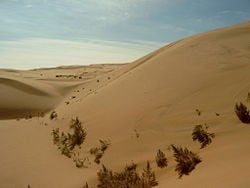
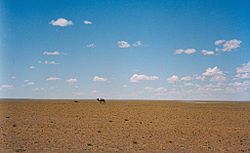
Ecoregions of the Gobi
The Gobi Desert is categorized by the World Wildlife Federation as consisting of two broadly defined ecoregions: The Gobi Steppe Desert and the Gobi Lakes Valley Desert Steppe region.
The Eastern Gobi Desert Steppe lies in the eastern portion of the Gobi Desert, reaching from the Inner Mongolia Palteau (found in China) into Mongolia. Overall, this region covers an area of approximately 108,800 square miles before its borders fade into the lush grasslands of Mongolia and Manchuria. Salt marshes and small ponds are commonly found in the lower elevations in this area, but disappear when the elevation rises to form the Yin Shan Mountain Range. The Eastern Gobi Desert Steppe is categorized by drought–adapted plant life and occasional thin wild grass patches. The Gobi Desert also harbors a few plant species that have been useful for both animals and humans alike, including: Wormwood, wild garlic, saltwort, and wild onion.
While the harsh environment and lack of visible vegetation may make the Gobi Desert appear inhospitable and unoccupied, the reverse appears to be true upon closer examination. The desert teems with life, boasting particularly large populations of Asian wild ass, Saiga antelope, black-tailed gazelle, and marbled polecat. Smaller animals and insects also contribute to the desert ecosystem, along with sizable bird populations.
The other ecosystem recognized by the World Wildlife Federation in the Gobi Desert is the Gobi Lakes Valley Desert Steppe, situated between the Khangai range and the Gobi-Altai and Mongol-Altai ranges in southwestern Mongolia. The Gobi Lakes Valley Desert Steppe is actually quite small for a complete ecosystem, measuring only 500 km long and 150 km wide. Despite its size, however, the region offers a broad range of landscape diversity, ranging from sand dunes to salt marshes. The most distinct feature of the area, however, and the one that earned the region its name, is the large number of lakes that dot the landscape. These lakes, mainly the Orog, Boontsagaan, Taatsyn tsagaan, and the Ulaan nuur provide an unusual geographic feature for an area technically classified as a desert.
Like the East Gobi Desert Steppe, all the plant life found in the Gobi Lakes Valley Desert Steppe region has adapted to the harsh conditions of life in the desert. In addition to the plants found in the East Gobi, the lakes of this region support a thriving aquatic community complete with marine animals and water-dwelling plant forms. Lakes and marshes also provide a valuable habitat for bird communities.
In regard to the mammalian occupants of the Gobi Lakes Valley, most of the species are able to survive in the difficult terrain by using the terrain to their best advantage. Common species found in the Gobi include: Midday gerbil, dwarf hamster, long-eared hedgehog, and the Tibetan hare. Smaller animals like these are able to hide in the shade during the heat of the day and avoid direct exposure to the glaring midday sun. Some larger animals, however, also choose to make the Gobi Lakes Valley Desert Steppe their home, including black-tailed Gazelle, Mongolian gazelle, and wild mountain sheep in the more mountainous regions.
Alternatively defined ecoregions
Alternative sources recognize ecoregions in the Gobi with the following definition:
The Eastern Gobi desert steppe is the easternmost of the Gobi ecoregions, covering an area of 281,800 km² (108,804 sq mi). It extends from the Inner Mongolian Plateau in China northward into Mongolia. It includes the Yin Mountains and many low-lying areas with salt pans and small ponds. It is bounded by the Mongolian-Manchurian grassland to the north, the Yellow River Plain to the southeast, and the Alashan Plateau semi-desert to the southeast and east.
The Alashan Plateau semi-desert lies west and southwest of the Eastern Gobi desert steppe. It consists of the desert basins and low mountains lying between the Gobi Altay range on the north, the Helan Mountains to the southeast, and the Qilian Mountains and northeastern portion of the Tibetan Plateau on the southwest.
The Gobi Lakes Valley desert steppe ecoregion lies north of Alashan Plateau semi-desert, between the Gobi Altay range to the south and the Khangai Mountains to the north.
The Junggar Basin semi-desert includes the desert basin lying between the Altay mountains on the north and the Tian Shan range on the south. It includes the northern portion of China's Xinjiang province and extends into the southeastern corner of Mongolia. The Alashan Plateau semi-desert lies to the east, and the Emin Valley steppe to the west, on the China-Kazakhstan border.
The Tian Shan range separates the Junggar Basin semi-desert from the Taklamakan Desert, which is a low, sandy desert basin surrounded by the high mountain ranges of the Tibetan Plateau to the south and the Pamirs to the west. The Taklamakan Desert ecoregion includes the Desert of Lop.
Sands of the Gobi Deserts
Despite the fact that much of the Gobi desert consists of gravel or rocky terrain, the few sand dunes that do exist continue to draw scientific inquiry and tourists alike. There are two major theories about the origins of the sand dunes in Mongolia. One theory, which is the more popular theory among scientists, states that the sands were carried into the desert on wind currents, much the way that water can carry sand. This theory has gained popularity as science has been able to track wind currents in the region, and the sand dunes have been proven to have developed along traditional wind paths. While this is the more predominant theory, an alternative idea exists that claims the sand dunes were originally a product of water erosion.
Climate
The Gobi Desert is noted for its extreme temperature variation, with days commonly dipping from sweltering midday heat to freezing temperatures at night. During the winter, the Gobi Desert experiences extremely low temperatures that are not found in other surrounding areas of China and Mongolia. The reason for the the cooler temperatures, like the formation of the sand dunes, is theorized to be the result of the strong winds that sweep across the plains of the Gobi Desert. Unstopped by any significant mountain formations, the winds add a chill to the temperature that makes life in the winter Gobi Desert particularly difficult.
The summer season, while marked by temperatures rising towards 100°F, is the rainy season for the Gobi Desert. The high temperatures bring with them the promise of rain, which is much needed for the inhabitants of the desert. While a welcome respite from the heat, the rains never seem to last long enough, annually only dropping about 4 to 6 inches (100 to 150 mm) on the plains.
Conservation efforts
The grasslands of the Gobi Desert are under extreme threat and may one day completely disappear if current practices in the region continue. The main culprit for the degradation of the grasslands is overgrazing by goats in the region, whose sheering fetches a high price in the form of cashmere. The problem of overgrazing has become compounded in recent years, as more and more people return to an agricultural lifestyle after the destruction of much of the urban economy of Mongolia.
The increase of agriculturalists in the area also threatens to detach much of the sand and topsoil in the desert. Under this threat, the loose sand or topsoil potentially could be swept away by the winds. This process is known as desertification, and is a common situation faced by deserts around the world.
On a scientific level, the Gobi Desert has also proven to be a valuable resource that needs to be conserved for future generations. The Gobi Desert harbors rich fossil remains, including dinosaur eggs and bones. Particularly, the Gobi Desert has been used to study the phenomenon commonly referred to as a "sand slides," where particle matter shifted on to living animals. This process, which resulted in death and physical preservation of the body, provides an important component for analyzing the extinction of dinosaurs.
History
The ancient Silk Road traversed the southern part of the Ala Shan Desert and crossed the Ka-shun Gobi as it skirted north and west around the Takla Makan Desert. The Gobi Desert remained relatively unknown to Western Europe until Marco Polo brought back his personal accounts of travel in the thirteenth century. Many other explorers followed Polo's example and voyaged through the Gobi Desert on the way to China. This trend led to an image, in Western Europe, of a Gobi Desert that was shaped by personal accounts and perceptions, not necessarily fact.
The harsh environment of the Gobi has proven prohibitive throughout history to permanent settled communities, and little of the advanced civilizations of China trickled into the desert. Those who did transverse the difficult terrain in its early history where commonly traders. Deserts often have to be crossed in order to reach potential markets, and the Gobi Desert was no exception. Trade routes dotted the gravel landscape, connecting the cities of Kalgan, Suzhou, Hami, and Beijing for economic purposes. Another significant route connected Kwei-hwa-cheng, Hami, annd Barku, while yet another ran between Lanzhou and Hami.
Another significant portion of the population of the Gobi Desert was herdsmen and agriculturalists who crossed the desert in search of suitable grazing land for their livestock. While the population of herdsmen declined with the industrialization of Mongolia, recent economic strife and unemployment has caused the nomadic population of the Gobi to rise again.
Global attention was once again focused on the region in the 1990s, when the area became a hot spot for paleontological research.
Ancient sites in the Gobi
Karakorum (also Kharakhorum or Khara Khorum) was an ancient palace and "capital city" of the Mongol Empire in the thirteenth century, although only for about 30 years. Its ruins lie in the northwestern corner of the Övörkhangai Province, near today's town of Kharkhorin, and adjacent to the Erdene Zuu monastery. It is part of the World Heritage Site Orkhon Valley Cultural Landscape.
Archaeological evidence reveals that town life centered on metallurgy powered by the currents of the Orkhon River. Other findings include arrowheads; iron cauldrons; wheel bushings; evidence of ceramic (tiles and sculpture) production, glass (glass beads) production and yarn (spindles) production; also Chinese silk and coins. The surrounding region consists of arable land and once hosted rich mining deposits. For all these finds, Karakorum has been dubbed the ancient "Empire of the Steppe."
The ruins of Karakorum were discovered by the Russian expedition of Nikolai Przhevalsky in 1889, several months after its leader's death. In Mongolia, some people favored relocating the national capital from Ulaanbaatar to nearby Kharkhorin.
Between 1948 and 1949, the Academy of Sciences of the U.S.S.R. explored the ancient site. Their findings include the discovery of the palace built by Ögedei and a Buddhist shrine built around 1300.
The Erdene Zuu monastery is probably the most ancient Buddhist monastery in Mongolia. It is adjacent to the ancient city of Karakorum and is also part of the World Heritage Site Orkhon Valley Cultural Landscape.
The monastery was built in 1585, by Abtai Sain Khan, upon the introduction of Buddhism into Mongolia as the state religion. Stones from the ruins of Karakorum were used in construction. It is surrounded by a wall featuring 108 stupas, 108 being a sacred number in Buddhism, and the number of beads in a Buddhist rosary. The monastery was damaged by warfare in the 1680s, but was rebuilt in the eighteenth century and, by 1872, contained 62 temples.
In 1939, the Communist leader Khorloogiin Choibalsan had the monastery ruined, as part of a purge that obliterated hundreds of monasteries in Mongolia and killed over ten thousand monks. Three small temples and the external wall with the stupas remained; the temples became museums in 1947. Erdene Zuu was allowed to remain as a museum only; the only functioning monastery in Mongolia was Gandantegchinlen Khiid Monastery in the capital, Ulaanbaatar. However, after the fall of Communism in Mongolia in 1990, the monastery was turned over to the lamas and Erdene Zuu again became a place of worship. Today it remains an active Buddhist monastery as well as a museum that is open to tourists.
ReferencesISBN links support NWE through referral fees
- Cable, Mildred and Francesca French. 1943. The Gobi Desert. London: Landsborough Publications.
- Costantino, Maria. 2001. The Illustrated Flag Handbook. New York: Gramercy Books. ISBN 0-517-21810-0
- Lewis, Brenda Ralph. 2002. Great Civilizations. Bath: Paragon Publishing. ISBN 0-75256-141-3
- Man, John. 1997. Gobi: Tracking the Desert. London: Weidenfeld & Nicolson.
- Mongolia Today. Terror Years. Retrieved November 19, 2007.
- Stewart, Stanley. 2001. In the Empire of Genghis Khan: A Journey Among Nomads. London: HarperCollins. ISBN 0-00-653027-3
- World Wide Religious News. August 25, 2006. Dalai Lama's visit shines spotlight on Mongolia's explosion of faiths. Retrieved November 19, 2007.
- World Wildlife Federation.Gobi Lakes Valley desert steppe. Retrieved November 15, 2007.
- This article incorporates text from the Encyclopædia Britannica Eleventh Edition, a publication now in the public domain.
| Deserts |
|---|
| Ad-Dahna | Alvord | Arabian | Aral Karakum | Atacama | Baja California | Barsuki | Betpak-Dala | Chalbi | Chihuahuan | Dasht-e Kavir | Dasht-e Lut | Dasht-e Margoh | Dasht-e Naomid | Gibson | Gobi | Great Basin | Great Sandy Desert | Great Victoria Desert | Kalahari | Karakum | Kyzylkum | Little Sandy Desert | Mojave | Namib | Nefud | Negev | Nubian | Ordos | Owyhee | Qaidam | Registan | Rub' al Khali | Ryn-Peski | Sahara | Saryesik-Atyrau | Sechura | Simpson | Sonoran | Strzelecki | Syrian | Taklamakan | Tanami | Thar | Tihamah | Ustyurt |
Credits
New World Encyclopedia writers and editors rewrote and completed the Wikipedia article in accordance with New World Encyclopedia standards. This article abides by terms of the Creative Commons CC-by-sa 3.0 License (CC-by-sa), which may be used and disseminated with proper attribution. Credit is due under the terms of this license that can reference both the New World Encyclopedia contributors and the selfless volunteer contributors of the Wikimedia Foundation. To cite this article click here for a list of acceptable citing formats.The history of earlier contributions by wikipedians is accessible to researchers here:
The history of this article since it was imported to New World Encyclopedia:
Note: Some restrictions may apply to use of individual images which are separately licensed.
